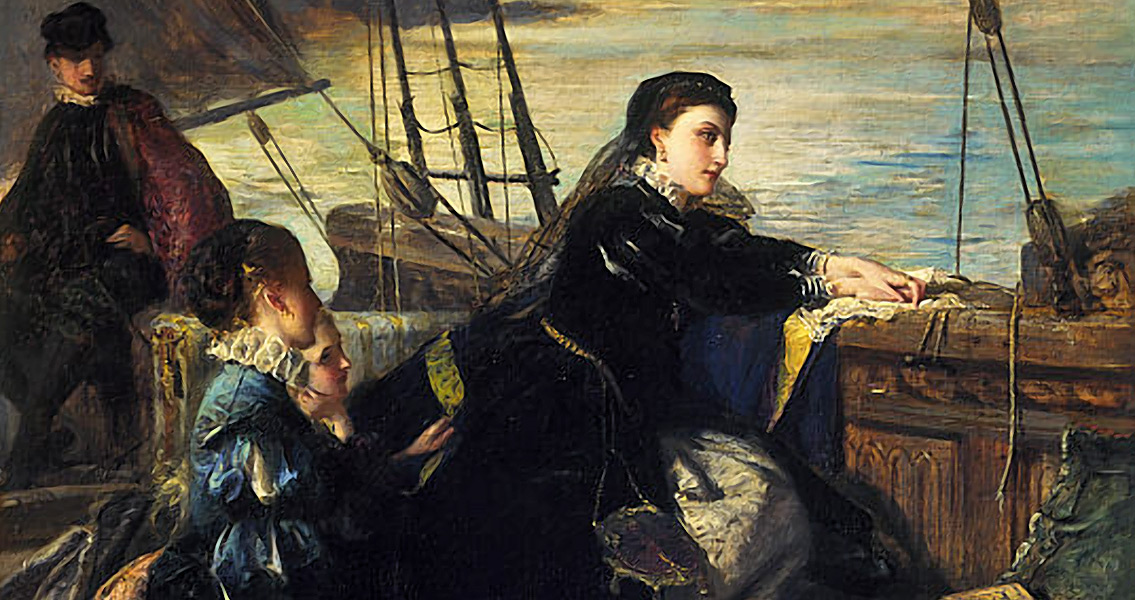<![CDATA[On 19th August, 1561, Mary Queen of Scots arrived in Leith, Scotland, to assume the Scottish throne. The nineteen year old queen had inherited the Scottish crown when she was just six days old, but lived in France for thirteen years from the age of six. Shortly after Mary Queen of Scots' birth a treaty was agreed between the Scottish and English governments that she would be betrothed to the son of Henry VIII. The English government had brokered the deal as a means to weaken the historic Auld Alliance which saw Scotland frequently side with France, leaving England in a precarious position politically and diplomatically. Partly inspired by continued English military incursions into Scottish territory, and partly by centuries of lingering resentment upon nationalistic and religious grounds, a group of influential Scottish Catholics conspired to break the treaty and betroth Mary to the French royal family. With Mary hidden away in Stirling Castle, English armies launched a series of attacks into Scottish territory known as the 'Rough Wooing', savagely attacking villages as part of a scorched earth policy to try and force Scotland to uphold the agreed marriage. The 'Rough Wooing' failed, and Mary was betrothed to the French Dauphin - Francis. In 1548 she was whisked away to France, and ten years later she married Francis. In 1559 he ascended to the French throne, giving Mary the title Queen of France, as well as Scotland. Her decision to return to Scotland came after King Francis' death from an ear infection in 1560. The move was a bold one, Mary Queen of Scots was a devout Roman Catholic but in her absence a series of reforms had seen Scotland become a Protestant country. Reassurances from her cousin Lord James Stewart convinced her that she would be safe to return to Scotland, and her arrival was met with a warm response. In 1565 she married Lord Darnley, a man deeply unpopular among the Scottish people. Renowned as a drunkard and brute, he killed Mary's friend David Rizzio in 1566 out of jealousy. The next year Darnley himself was killed following an explosion at Kirk O'Field. Mary had left the site shortly before the explosion, leading to theories that she had conspired with her future third husband, the Earl of Bothwell, to have Darnley killed. The Earl of Bothwell proved just as unpopular as Darnley, and an uprising by Scottish nobles saw Mary's armies quickly defeated at Glasgow on 13th May 1568. Bothwell fled to Europe, while Mary was imprisoned in Lochleven Castle, where she was forced to surrender the throne to her son James. After ten months in captivity a group of Mary's supporters helped her break out of the jail at Lochleven Castle. After an army she had raised suffered a cataclysmic defeat at a battle in Edinburgh, she decided to flee to England, hoping Queen Elizabeth - Mary's cousin and the Godmother to her son - would assist in her attempts to reclaim the Scottish throne. The decision proved to be a bad one. Unbeknownst to Mary, Elizabeth had been secretly aiding Mary's enemies in the north in an attempt to undermine her closest rival to the English throne (Mary was the great grand daughter of the former English king, Henry VII). Following her arrival in England Mary was immediately imprisoned, and would remain so for nineteen years. For a number of reasons Elizabeth sought to keep her cousin away from the public. Elizabeth's England had reached a level of religious stability unheard of in the country for centuries. The arrival of the Roman Catholic Mary could have broken this stability, providing a figure for England's Catholic population to rally behind to break the country's Protestant dominance. Just as significantly, Elizabeth was the daughter of Henry VIII and Anne Boleyn, a marriage many considered illegal and thus void - making Elizabeth illegitimate with no claim to the throne in some people's eyes. The fact that Mary was the next closest heir to the throne after Elizabeth again set her out as a potentially dangerous figure to have in the country. Elizabeth had her spy network gather evidence on Mary, following several assassination attempts on the English queen. Whether Mary was actually involved in any of these plots is unclear, but the sheer fact of her existence gave validation for Catholics to assassinate Elizabeth so Mary could inherit the throne. In 1587 Mary was trialed and found guilty of plotting to kill Elizabeth. She was executed on 8th February, 1587. ]]>
Mary Queen Of Scots Assumes Scottish Throne
